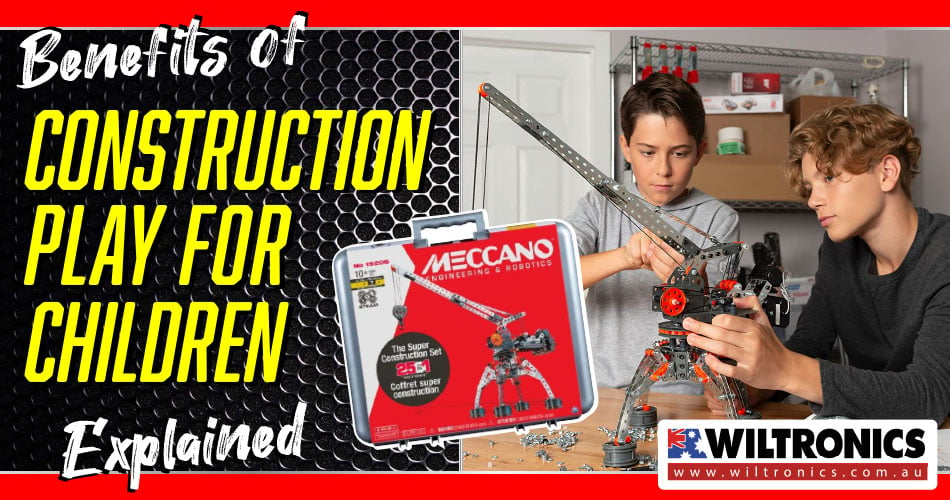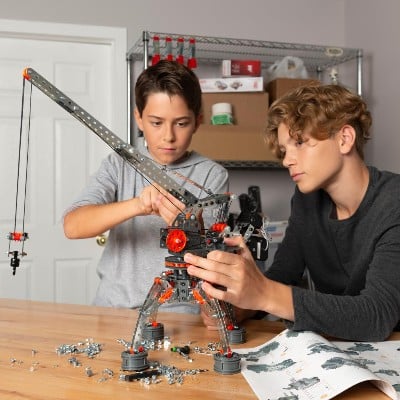Benefits of Construction Play for Children Explained
January 12, 2023

This list of benefits of construction play proves that there are more rewards than just pure amusement for kids!
Any activities that involve ‘fun’ are a thumbs-ups to children. But besides the enjoyment, they may also gain multiple formative benefits. This is particularly true when they are engaged in building things — cue construction play.
Defining ‘Construction Play’
There are many types of play for children. One is called ‘physical play’, wherein kids fulfil big and small movements. These include running, jumping, and riding (e.g. bike and scooter) – as well as picking up a pencil and tying a knot.
Another common type most children engage in is constructive play. At its simplest, constructive play entails manipulating toys or objects to create something. It is a form of hands-on inquiry where kids, by nature, learn and explore things for themselves.
Building and construction projects can stimulate their creativity and sharpen crucial skills. Take stacking, for example. It is a goal-oriented play that can encourage a child to think outside the box.
Other constructive plays your little one can enjoy and benefit from include:
- Assembling
- Cutting
- Moulding
- Testing

Examples of Constructive Play
Construction play can take on many different forms. From drawing a house to building with engineering toys, a child can learn so much.
- Blocks. The most common type of constructive play. Block play, as the name suggests, involves playing with blocks. It is a form of open-ended activity with no set rules, and children are fully in control. Lego is a great example of this.
- Box construction. This play covers buildings with boxes in various shapes and sizes. You may be surprised how a child’s imagination and creativity can expand with this. They can come up with incredible rockets, buildings such as their own playhouse, or a 3D car! Ideal for home and school play.
- Clay and play dough. Playing with clay and playdough helps children develop eye-hand coordination. Plus, develop their hands’ strength, dexterity, and control. Examples include making a dot pattern using a fork, pressing a seashell into clay, or making tracks with a toy car.
- Construction sets. This kind of children’s toy comes with separate pieces, which kids can put together. Some are magnetic, and others are screwed or linked. Have a look at this Meccano 25-in-1 Super Construction Set. It includes real tools and metal parts to provide a real building experience. Turn the 638 pieces into a crane model, a helicopter or a broadcasting vehicle! Suitable for kids ages ten and above.
- Puzzles. A puzzle is a game problem that may take many forms, including toys. It is solved through knowledge and can sharpen memory and develop spatial skills. As children handle small pieces, they also strengthen their finger muscles.
- Sand and water play. Build a sand village, wash a baby doll in water, or chase bubbles in the air. This type of play can provide children with many learning experiences.
- Woodworking. Woodworking in early childhood is a powerful medium for creativity and critical thinking. Sawing, hammering nails, and fitting nuts and bolts can enhance their construction skills.
Benefits of Construction Play
Construction play offers children fantastic benefits that extend beyond the playroom. Below are a few of the remarkable developmental benefits of construction play sets:
1. Sparks creativity
Exposing kids to constructive play at an early age can help boost their way of thinking. Possibilities become endless and lateral thinking is encouraged. For instance, when experimenting with a variety of materials and discovering new uses.
This is also where the ‘thinking outside the box’ comes in. Say you let them create a fort of blankets instead of setting up a store-bought tent. With such an open-ended type of play, they can utilise this skill as they grow up.
2. Stimulate problem-solving
Take the trial-and-error method, for example. This could be figuring out how to make the sand firmer or hold the tent up. Overcoming problems to build instructions will aid their problem-solving skills. In turn, they can achieve their desired outcome.
3. Introduces mathematical concepts
Besides problem-solving, children may also be introduced to mathematical concepts. Measuring and understanding the size can take place in a purposeful context. Construction play can also teach them about shapes, sorting, matching and classifying.
4. Fine motor skills development
Crawling, stretching, grabbing and pulling – simply moving their bodies – help with muscle development. Moreover, positioning and piecing together the pieces can assist a child’s small muscles. This hones their fine motor skill abilities in the long run. Therefore, their body becomes more complete and developed.
5. Hand-eye coordination
The ability to perform activities that involve the simultaneous use of hands & eyes. As a child starts to build, their eyes send visual information to the brain, telling where the hand is placed. The brain then generates instructions for how the hands move to achieve a task. This may be catching a ball, picking up an object, and writing or typing.
Often, children will work together in pairs or small groups to complete the task. It allows them to engage with one another and contribute towards a shared goal. This could be something as simple as passing bricks or buckets to each other.
And during the process, they will learn to listen, take turns and cooperate. Eventually, they will strengthen their social skills and become a better team player.
7. Teach focus, patience and persistence
Construction play requires a level of planning, focus and persistence. To ensure their project comes to fruition, children need to have these qualities. Particularly patience when something does not go to plan. Sooner or later, they will recognise these attributes and use them to their own benefit.
The Bottom Line
The benefits of constructive play show how to make a difference in the way a child thinks and achieves a task. Make them choose their own toys and ensure they are age-appropriate for successful playing. Check out our Make and Create section for a variety of options!
Note: Adults can also offer their aid and support to children. Such as when testing ideas, solving problems or developing imagination.
© Wiltronics Research Pty Ltd 2023
Write a Comment
You must be logged in to post a comment.